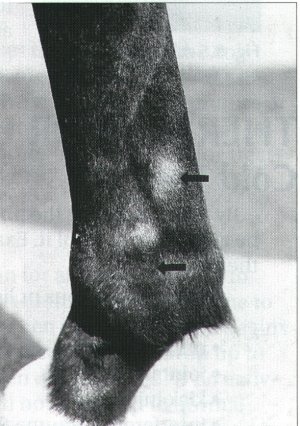 Back
Back
LEG SWELLING IN HORSES & PONIES First broadcast on www.provet.co.uk |
This information is provided by Provet for educational purposes only.
You should seek the advice of your veterinarian if your pet is ill as only he or she can correctly advise on the diagnosis and recommend the treatment that is most appropriate for your pet.
Swelling of the leg can occur suddenly or gradually. There are many causes , so it is important to get an accurate diagnosis from your veterinarian as soon as possible.
Swelling of the leg may or may not be accompanied by lameness, but often there is discomfort because any form of swelling stretches the soft tissues of the leg and puts pressure on adjacent structures. Usually only one leg is affected, but occasionally more than one leg can be swollen.
A swelling may involve :
- The skin
- Soft tissues under the skin
- Tendons
- A joint
- The underlying bone
If the swelling is associated with infection there may be an obvious cut or puncture wound in the skin, and for swelling of the pastern there may be a wound or foreign body, such as a nail, in the foot, so careful cleaning and examination of the foot is needed.
Infection and other causes of inflammation may cause a local increase in temperature of the swelling so it is hot to the touch.
There are many causes of leg swelling including :
- Trauma - kicks, knocks, wounding by sharp objects, falls, tendon or ligament injuries (strains, sprains or ruptures)
- Infection
- Circulatory problems - cause fluid accumulation in tissues called oedema. This may involve more than one leg.
- Pregnancy can cause leg swelling by impairing circulation
- Joint diseases - arthritis, osteochondrosis, epiphysitis, dislocations
- Bone diseases - fractures
- Cancer - uncommon
- Heart failure
- Protein deficiency - dietary deficiency, or excess protein losses seen in various diseases
- Allergy
- Vaccine reactions
- Viral infections (flu or viral arteritis)
Swelling at any particular site may be due to a variety of causes, for example swelling around the fetlock due to inflammation (called windgalls) may be due to :
- Too much work
- Injury
- Nutritional problems

Two windgalls .
(Photo from Veterinary Manual for the Performance Horse by Nancy Loving with A.M.Johnston Reproduced with the kind permission of Blackwell Science. This book is available from Provet's on-line bookshop info@provet.co.uk )
In young foals common causes of leg swelling include :
- Rupture of a tendon in front of the cannon bone (the common digital extensor tendon)
- Growth plate inflammation (epiphysitis)
- Multiple joint infection secondary to infection of the navel - called "navel-ill"
as well as
- Trauma
If swelling of the legs is not treated early and correctly it can lead to secondary problems - for example infection in soft tissues can lead to infection of underlying bone (osteomyelitis) which is much more serious, so it is important to get professional advice as soon as possible.
Updated October 2013